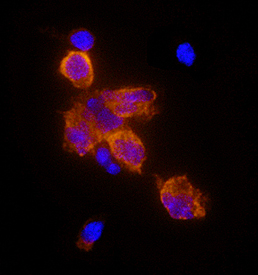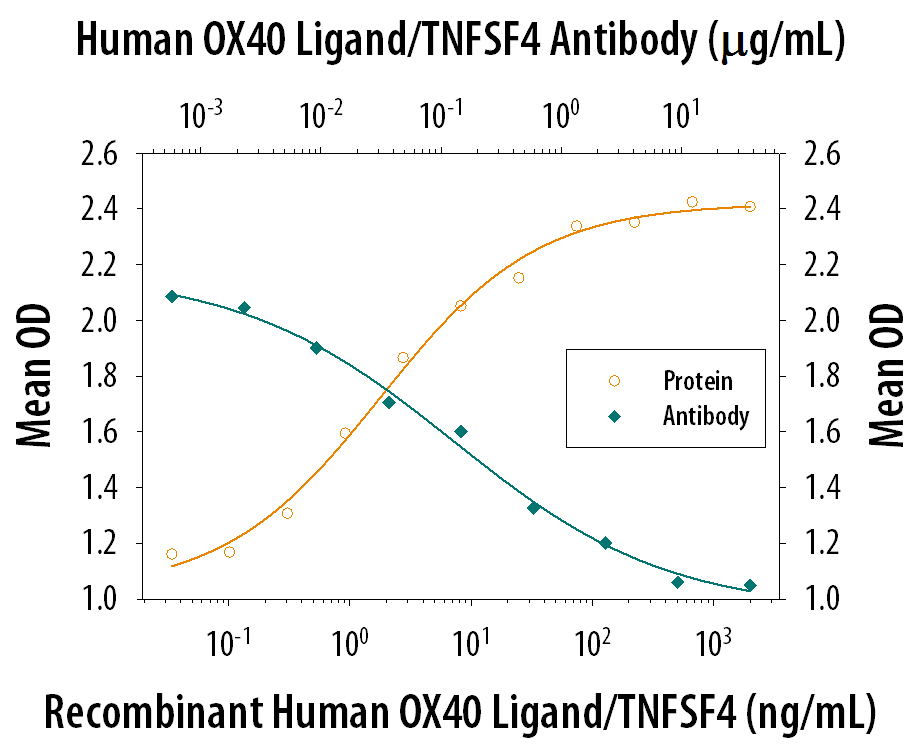Human OX40 Ligand/TNFSF4 Antibody Summary
Gln51-Leu183
Accession # P23510
Applications
Please Note: Optimal dilutions should be determined by each laboratory for each application. General Protocols are available in the Technical Information section on our website.
Scientific Data
 View Larger
View Larger
Detection of OX40 Ligand/ TNFSF4 in Human Mature Dendritic Cells by Flow Cytometry. Human mature dentritic cells differentated from human peripheral blood mononuclear cell derived CD14+cells treated with 20 ng/mL Recombinant Human IL-4 (Catalog # 204-IL) and 50 ng/mL Recombinant Human GM-CSF (Catalog # 215-GM) for 7 days and 1 µg/mL LPS, 20 ng/mL Recombinant Human TNF-a (Catalog # 210-TA), and 20 ng/mL Recombinant Human IL-1 beta /IL-1F2 (Catalog # 201-LB) for last 24 hours were stained with Mouse Anti-Human OX40 Ligand/TNFSF4 Monoclonal Antibody(Catalog # MAB10541, filled histogram) or isotype control (Catalog # MAB002, open histogram), followed by Goat F(ab)2 Anti-Mouse IgG (H+L) Allophycocyanin (Catalog # F0101B).
 View Larger
View Larger
OX40 Ligand/TNFSF4 in Human PBMCs. OX40 Ligand/TNFSF4 was detected in immersion fixed human peripheral blood mononuclear cells (PBMCs) stimulated with LPS using Mouse Anti-Human OX40 Ligand/ TNFSF4 Monoclonal Antibody (Catalog # MAB10541) at 25 µg/mL for 3 hours at room temperature. Cells were stained using the NorthernLights™ 557-conjugated Anti-Mouse IgG Secondary Antibody (orange; Catalog # NL007) and counterstained with DAPI (blue). View our protocol for Fluorescent ICC Staining of Non-adherent Cells.
 View Larger
View Larger
IL‑8 Secretion Induced by OX40 Ligand/TNFSF4 and Neutralization by Human OX40 Ligand/TNFSF4 Antibody. Recombinant Human OX40 Ligand/TNFSF4 (Catalog # 1054-OX) induces IL-8 secretion in the HT1080 human fibrosarcoma cell line transfected with human OX40 in a dose-dependent manner (orange line) as measured by Human IL-8 Duoset (Catalog # DY208). IL-8 Secretion elicited by Recombinant Human OX40 Ligand/TNFSF4 (10 ng/mL) is neutralized (green line) by increasing concentrations of Mouse Anti-Human OX40 Ligand/TNFSF4 Monoclonal Antibody (Catalog # MAB10541). The ND50 is typically 0.1-0.6 µg/mL.
Reconstitution Calculator
Preparation and Storage
- 12 months from date of receipt, -20 to -70 °C as supplied.
- 1 month, 2 to 8 °C under sterile conditions after reconstitution.
- 6 months, -20 to -70 °C under sterile conditions after reconstitution.
Background: OX40 Ligand/TNFSF4
OX40 Ligand (OX40L), also known as gp34, is a type II transmembrane glycoprotein designated TNFSF4 within the TNF superfamily. Human OX40L cDNA encodes a 183 amino acids (aa) polypeptide with an amino-terminal cytoplasmic domain (aa 1-23) and a carboxy-terminal extracellular domain (aa 51-183). It shares 46% aa sequence identity with the mouse counterpart. OX40L is expressed on the surface of activated B cells, T cells, dendritic cells and endothelial cells. Like other TNF superfamily members, membrane-bound OX40 Ligand exists as a homotrimer. OX40L binds to OX40 (CD134), a member of the TNF receptor superfamily that is expressed predominantly on activated CD4+ T cells. OX40 Ligand is one of the group of co-stimulatory molecules in the immune system that includes B7, CD40 Ligand, CD30 Ligand, CD27 Ligand and 4-1BB Ligand. OX40 appears as a late activation-induced T cell surface antigen, and its major function of OX40-OX40L interaction may be to transmit a late co-stimulatory signal to promote the survival and proliferation of activated CD4+ T cells and prolong the immune response. Engagement of OX40 on activated T cells in situ in tumors has been shown to augment immune responses and subsequent tumor regression.
- Godfrey, W.R. et al. (1994) J. Exp. Med. 180:757.
- Baum, P.R. et al. (1994) EMBO J. 13:3992.
- Al-Shamkhani, A. et al. (1997) J. Biol. Chem. 272:5275.
- Kjaergaard, J. et al. (2000) Cancer Res. 60:5514.
Product Datasheets
Citations for Human OX40 Ligand/TNFSF4 Antibody
R&D Systems personnel manually curate a database that contains references using R&D Systems products. The data collected includes not only links to publications in PubMed, but also provides information about sample types, species, and experimental conditions.
6
Citations: Showing 1 - 6
Filter your results:
Filter by:
-
Predictive biomarkers for the responsiveness of recurrent glioblastomas to activated killer cell immunotherapy
Authors: S Hwang, J Lim, H Kang, JY Jeong, JG Joung, J Heo, D Jung, K Cho, HJ An
Cell & bioscience, 2023-01-24;13(1):17.
Species: Human
Sample Types: Whole Cells
Applications: Neutralization -
OX40L/OX40 axis impairs follicular and natural Treg function in human SLE
Authors: C Jacquemin, JF Augusto, M Scherlinge, N Gensous, E Forcade, I Douchet, E Levionnois, C Richez, E Lazaro, P Duffau, ME Truchetet, J Seneschal, L Couzi, JL Pellegrin, JF Viallard, T Schaeverbe, V Pascual, C Contin-Bor, P Blanco
JCI Insight, 2018-12-20;3(24):.
Species: Human
Sample Types: Whole Tissue
Applications: IHC -
Dectin-1/2-induced autocrine PGE2 signaling licenses dendritic cells to prime Th2 responses
Authors: MMM Kaisar, M Ritter, C Del Fresno, HS Jónasdótti, AJ van der Ha, LR Pelgrom, G Schramm, LE Layland, D Sancho, C Prazeres d, M Giera, M Yazdanbakh, B Everts
PLoS Biol., 2018-04-18;16(4):e2005504.
Species: Human
Sample Types: Whole Cells
Applications: Neutralization -
Activated Human CD4+CD45RO+ Memory T-Cells Indirectly Inhibit NLRP3 Inflammasome Activation through Downregulation of P2X7R Signalling.
Authors: Beynon V, Quintana FJ, Weiner HL
PLoS ONE, 2012-06-29;7(6):e39576.
Species: Human
Sample Types: Whole Cells
Applications: Neutralization -
B7-CD28 costimulatory signals control the survival and proliferation of murine and human gammadelta T cells via IL-2 production.
J. Immunol., 2012-06-25;189(3):1202-8.
Species: Human
Sample Types: Whole Cells
Applications: Neutralization -
Cord blood CD4(+)CD25(+)-derived T regulatory cell lines express FoxP3 protein and manifest potent suppressor function.
Authors: Godfrey WR, Spoden DJ, Ge YG, Baker SR, Liu B, Levine BL, June CH, Blazar BR, Porter SB
Blood, 2004-09-16;105(2):750-8.
Species: Human
Sample Types: Cell Culture Supernates
Applications: Neutralization
FAQs
No product specific FAQs exist for this product, however you may
View all Antibody FAQsReviews for Human OX40 Ligand/TNFSF4 Antibody
There are currently no reviews for this product. Be the first to review Human OX40 Ligand/TNFSF4 Antibody and earn rewards!
Have you used Human OX40 Ligand/TNFSF4 Antibody?
Submit a review and receive an Amazon gift card.
$25/€18/£15/$25CAN/¥75 Yuan/¥2500 Yen for a review with an image
$10/€7/£6/$10 CAD/¥70 Yuan/¥1110 Yen for a review without an image



